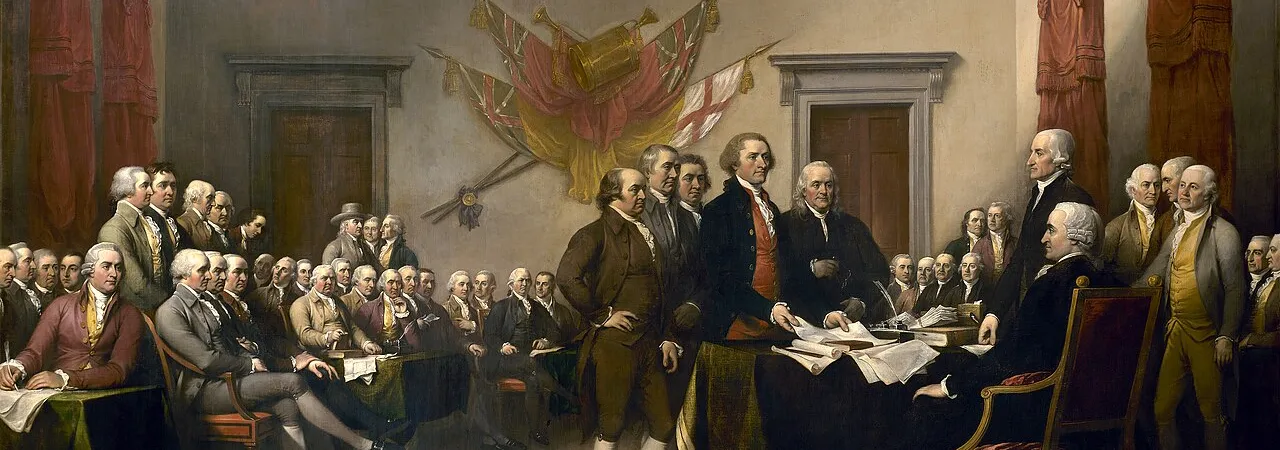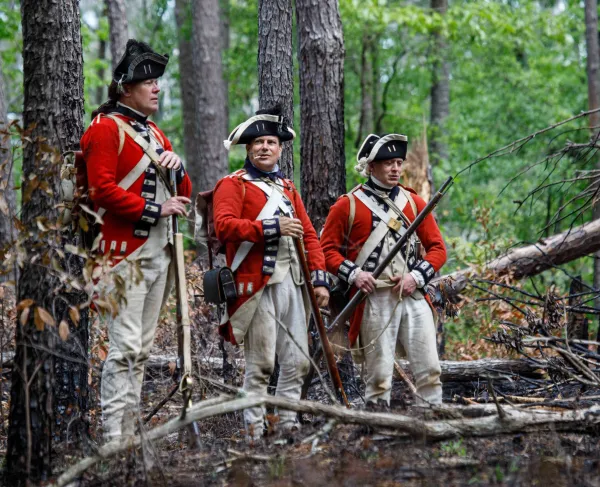
John Trumbull's painting, Declaration of Independence, depicts the moment on June 28, 1776, when the first draft of the Declaration of Independence was presented to the Second Continental Congress.
On July 4, 1776, the 56 delegated to Second Continental Congress ratified the Declaration of Independence. The document was primarily written by Thomas Jefferson as a part of the Committee of Five, which also included John Adams, Ben Franklin, Roger Sherman, and Robert R. Livingston. Twelve colonies approved the Declaration on that now-famous day with New York ratifying a few days later. Counter to popular belief, the delegates met to sign the Declaration of Independence nearly a month after the Fourth, on August 2, with the last delegate not signing until November 4. Delegate Benjamin Rush later recounted the event as signing “our own death warrants.”
The 56 signers came from widely different backgrounds from all thirteen colonies. A plurality, 23 out of 56, were lawyers. The next most common occupations were merchants and plantation owners, with 12 delegates each. The rest were a mix of physicians, farmers, land speculators, scientists, printers, with even a musician in Francis Hopkinson and a minister in John Witherspoon. Robert Morris and Charles Carroll of Carrollton were, by some estimates, the two wealthiest men in the colonies. Interestingly, Caroll was also the only Catholic signer. Other signers, like Sam Adams, could not even afford a nice suit to wear to the First Continental Congress. His fellow Massachusetts delegate John Hancock bought one for him. The average age at the Continental Congress was 44 and half. South Carolina’s Edward Rutledge was the youngest at 26 and Pennsylvania’s Ben Franklin the oldest at 70. Eight signers were immigrants: three Irish, two English, two Scottish, and one Welsh. While eight went to Harvard University, four to the College of William and Mary, and four to Yale University, another five were self-educated, never receiving formal schooling. Forty-one of them were slave owners, some like Thomas Jefferson owning hundreds of enslaved people.
Many were involved in the crises of the road to Revolution. Three served as delegates to the 1765 Stamp Act Congress: Thomas McKean, Caesar Rodney and John Morton. Quite peculiarly, John Adams defended the British soldiers perpetrating the Boston Massacre against prosecutor Robert Treat Paine, a fellow signer. Perhaps surprisingly, multiple signers served as colonial officials as justices and assembly members. With the rising tensions with Great Britain, especially after the Boston Port Act, they turned on the Crown.
At the Continental Congress, Pennsylvania and Virginia had the most delegates with nine and seven, respectively. Not all delegates signed the Declaration, and not all signers held office during the ratification on the document on July 4. John Dickinson, the famous author of Letters from a Farmer in Pennsylvania, abstained from voting and refused to sign the Declaration of Independence. He was the most adamant objector to separating from Great Britain. John Hancock, as the president of the Continental Congress, signed his name the biggest, his name since becoming synonymous with signatures. Not all famous patriots would sign the documents, including George Washington, Alexander Hamilton, John Jay, Patrick Henry, and Thomas Paine.
Throughout the Revolutionary War, at least 14 served in their state militias or the Continental Army itself. Other signers, Robert Morris most notably, would act as financiers for the cause. Richard Stockton would be captured by the British in late 1776 while trying to evacuate his family from Perth Amboy, New Jersey. Thomas Heyward Jr. and Edward Rutledge would both be taken as prisoners of war following the Siege of Charleston in 1780. Many signers would face British retaliation, having their houses burned down or wives captured.
Many of these men would go on to have illustrious political careers. Sixteen would also sign the Articles of Confederation and six–– Ben Franklin, George Clymer, James Wilson, George Read, Roger Sherman, and Robert Morris––would sign the Constitution. Most signers would go on to serve in state and federal governments as assemblymen, judges, representatives, senators, and governors. Samuel Chase and James Wilson were both appointed to the Supreme Court, the former being the only Supreme Court justice to ever be impeached. Three men, John Adams, Thomas Jefferson, and Elbridge Gerry, became the first, second, and fifth vice presidents, respectively. Adams and Jefferson would later be elected as the second and third presidents. John Adam’s son, John Quincy Adams, would become the sixth president. Benjamin Harrison V was the father of ninth president William Henry Harrison and great-grandfather of twenty-third president Benjamin Harrison.
John Morton was the first to pass away in April 1777. While most would die naturally or of disease over the coming decades, Button Gwinnett died in a duel with Brigadier General Lachlan McIntosh and Thomas Lynch Jr. would pass in a shipwreck. John Adams and Thomas Jefferson would pass away hours apart on July 4, 1826, the 50th anniversary of the signing. Charles Carroll of Carrollton was the last surviving signer, passing away on Nov 14, 1832, at the age of 95, 56 years after the signing.





